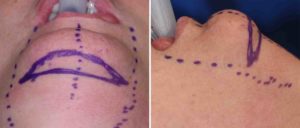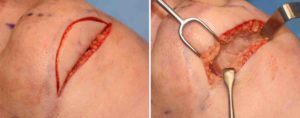The chin has many potential deformities that occur to it as the most projecting structure of the lower face. It is most common to think of chin deformities as bony in origin and that augmentation or reduction of its projection is the aesthetic objective. But the overlying soft tissues of the chin are also prone to deformities that affect the mentalis muscle or the position/bulk of the soft tissue chin pad.
One type of soft tissue chin deformity is that of hyperdynamic chin ptosis. This is an aesthetic chin issue that only appears when one animates or smiles. At rest the chin profile looks normal or only has a slight amount of an excessive chin pad. But with smiling the soft tissue chin pad elongates and pulls down. In some cases oblique lines or indentations extend upward onto the face lateral to the chin as an extension of the downwardly displaced chin pad. Besides vertical chin lengthening the linear line of the jaw is disrupted in profile.


Dr. Barry Eppley
Indianapolis, Indiana


